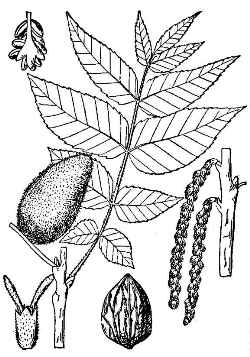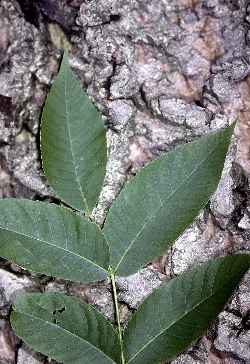
Juglans cinerea, Britton, N.L., and A. Brown. 1913. Illustrated flora of the northern states and Canada. Vol. 1: 579.
Sunset®: 1-9,14-21
USDA: 3-8
Sun Exposure: Full sun
Origin: Eastern North America, southern Ontario to eastern Texas
Growth Habits: Small to medium-sized deciduous tree, relatively short lived, fast growing to 40 to 60 feet tall (12-18 m) or more, 30 to 50 feet spread (9-15 m); alternate, odd-pinnately compound leaves, 10 to 25 inches long (25-62 cm), with 11 to 19 serrated leaflets, 3 to 5 inches long (7.5-12.5 cm), odoriferous when bruised, their underside densely covered with stellate hairs
Watering Needs: Moist, well drained soils, relatively drought resistant
Propagation: Seed, cuttings

Juglans nigra bark and leaf, Robert H. Mohlenbrock. USDA NRCS. 1995. Northeast wetland flora: Field office guide to plant species.
Blooming Habits:
The male flowers are long catkins, 2.4 to 5.6 inches long (6-14 cm). The female flowers are yellowish green, on short spikes, close to the end of the twigs. The black walnut blooms in the spring (April to June).
Fruiting Habits:
The fruit is a elongated nut, 1 to 1.6 inches in diameter (2.5-4 cm), containing a tasty, oily seed, ripening in the fall (September-October). It generally stays on the tree until early winter. It is surrounded by a very hard thick shell. The husk is oblong and sticky.
Culture:
As is typical among the walnuts, the butternut secretes a substance (juglone) that prevents close-by plants to grow.
Desert-Tropicals is dedicated to provide gardening advice, gardening ideas, and information about flower of all kind for landscape and collections.We try to check carefully the identification of the plants on the illustrations as well as the other information from the page, but occasionally errors do occur. if you notice anything that needs to be changed please contact us.Thanks.
© 1998-2020 Philippe Faucon, All Rights Reserved.